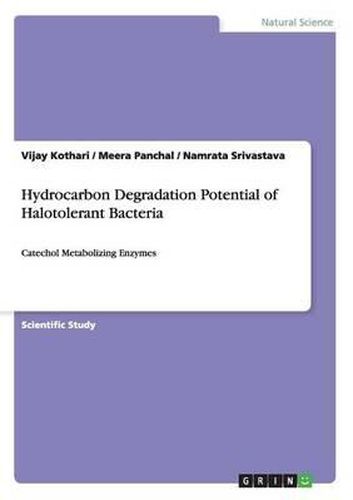Readings Newsletter
Become a Readings Member to make your shopping experience even easier.
Sign in or sign up for free!
You’re not far away from qualifying for FREE standard shipping within Australia
You’ve qualified for FREE standard shipping within Australia
The cart is loading…






Scientific Study from the year 2013 in the subject Biology - Micro- and Molecular Biology, grade: A, Nirma University (Institute of Science), language: English, abstract: Hydrocarbon contamination of marine ecosystems has been a major environmental concern. Hydrocarbon metabolizing capacity of four halotolerant bacteria (Bacillus atrophaeus, Halomonas shengliensis, Halomonas koreensis, and Virgibacillus salarius) isolated from saline soil of Khambhat, India was investigated. Presence of catechol metabolizing enzymes (catechol 2,3 dioxygenase, chlorocatechol 1,2 dioxygenase, and protocatechuate 3,4 dioxygenase) was checked in V. salarius, as only this among all the test organisms could grow on the hydrocarbon substrates used, and compared with Pseudomonas oleovorans. Effect of salinity of the growth medium on activity of catechol metabolizing enzymes was also studied. Catechol 2,3 dioxygenase activity in both the organisms was more susceptible to increase in salinity of the growth medium than chlorocatechol 1,2-dioxygenase activity. To the best of our awareness, this is the first report of catechol metabolism in V. salarius. V. salarius was found to be capable of weak biofilm formation. As V. salarius is capable of growing at high salt concentration, alkaline pH, hydrocarbon degradation, and also of growth in presence of various metal ions, it can be an attractive candidate for bioremediation of marine oil spills. Organisms like V. salarius can also serve as a model for multiple stress tolerance in prokaryotes.
$9.00 standard shipping within Australia
FREE standard shipping within Australia for orders over $100.00
Express & International shipping calculated at checkout
Scientific Study from the year 2013 in the subject Biology - Micro- and Molecular Biology, grade: A, Nirma University (Institute of Science), language: English, abstract: Hydrocarbon contamination of marine ecosystems has been a major environmental concern. Hydrocarbon metabolizing capacity of four halotolerant bacteria (Bacillus atrophaeus, Halomonas shengliensis, Halomonas koreensis, and Virgibacillus salarius) isolated from saline soil of Khambhat, India was investigated. Presence of catechol metabolizing enzymes (catechol 2,3 dioxygenase, chlorocatechol 1,2 dioxygenase, and protocatechuate 3,4 dioxygenase) was checked in V. salarius, as only this among all the test organisms could grow on the hydrocarbon substrates used, and compared with Pseudomonas oleovorans. Effect of salinity of the growth medium on activity of catechol metabolizing enzymes was also studied. Catechol 2,3 dioxygenase activity in both the organisms was more susceptible to increase in salinity of the growth medium than chlorocatechol 1,2-dioxygenase activity. To the best of our awareness, this is the first report of catechol metabolism in V. salarius. V. salarius was found to be capable of weak biofilm formation. As V. salarius is capable of growing at high salt concentration, alkaline pH, hydrocarbon degradation, and also of growth in presence of various metal ions, it can be an attractive candidate for bioremediation of marine oil spills. Organisms like V. salarius can also serve as a model for multiple stress tolerance in prokaryotes.